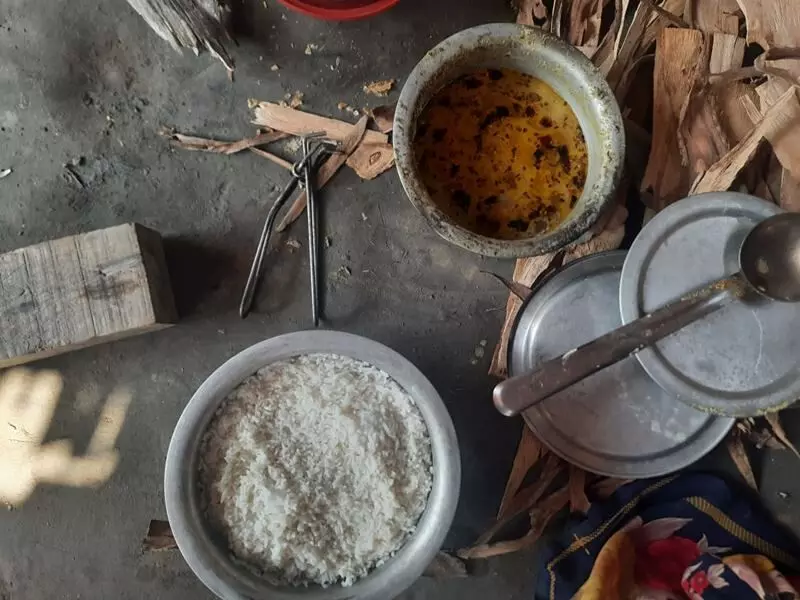8 out of 10 Indian households faced food insecurity last year despite free ration relief: Survey
Two years into the pandemic and the hunger and food insecurity crisis continues. A survey reported decline in nutritional quality and quantity of food despite some of the government schemes on food grains having performed well. Details here.
 गाँव कनेक्शन 24 Feb 2022 11:40 AM GMT
गाँव कनेक्शन 24 Feb 2022 11:40 AM GMT

Lunch prepared by a poor household for its malnourished children in Lakhimpur Kheri, Uttar Pradesh. Photo: Shivani Gupta
About eight in 10 surveyed Indian households — 79 per cent — have reported some form of food insecurity during the pandemic and an alarmingly high 25 per cent reported severe food insecurity. In addition to this, 41 per cent reported a deterioration in the nutritional quality of their diet when compared to pre-pandemic times.
These are the findings of a survey that has documented the hunger situation six months after the second wave of the COVID19 pandemic in India. The survey titled Hunger Watch-II was conducted by the Right to Food Campaign and the Centre for Equity Studies between December 2021 and January 2022, and was released on February 23.
As part of the survey, a total of 6,697 respondents — 72.8 per cent in rural areas and 27.1 per cent in urban areas — were interviewed across 14 states including Uttar Pradesh, Delhi, Gujarat, Tamil Nadu and West Bengal.
Of these, a third reported they or someone in their household had gone to bed hungry in the month preceding the survey. Only 34 per cent said that their consumption of cereals in the last month was sufficient.
A large proportion of households reported that they had not eaten nutritious foods more than twice or thrice a month. Only 27 per cent of the respondents reported eating eggs, flesh, milk, fruits and dark green leafy vegetables more than once a week.
More than one-third of the respondents felt that their nutrition quality will remain the same or will get worse in the next three months.
Compromise in nutrition schemes for vulnerable
However, according to the survey, some of government schemes had performed well during the pandemic. For instance, over 90 per cent of those who had a ration card said they received food grains under the public distribution system of the country. Under the National Food Security Act (NFSA), 2013, each beneficiary is entitled five kilos of cereals per person per month at highly subsidised prices.
Under the Pradhan Mantri Garib Kalyan Anna Yojana (PMGKAY), the Indian government provides an additional five kg each of rice or wheat a month free of cost to more than 800 million ration card holders. This is in addition to the five kilos of food grains under the NFSA. The scheme was introduced as part of the first COVID19 relief package in April 2020.
Interestingly, a quarter (24 per cent) of households with eligible members said that they did not receive any mid day meal transfers either in the form of cooked meals, dry rations or in cash. This rose to 28 per cent for the ICDS [Integrated Child Development Services] transfers to eligible mothers or children, who are among those most vulnerable to hunger and malnourishment.
The survey also pointed out that the budgets for many of these schemes have been declining in the last few years. For instance, the budget for ICDS has seen a 38 per cent cut in real terms in 2022-23 compared to 2014-15, and the mid day meal scheme has seen nearly 50 per cent reduction in real terms.
Low incomes, high debt
As per the Hunger Watch Survey-II report, 66 per cent of the respondents said that their income decreased as compared to the pre-pandemic period. Overall, one third (31 per cent) of the total respondents said that their current income is less than half of what they earned pre-pandemic. In addition to this, 70 per cent of the households with working members were found to have a total monthly income of less than Rs 7,000.
Meanwhile, close to 45 per cent of the households had outstanding debt with 21 per cent respondents having debts of more than Rs 50,000.
Along with the decreasing monthly incomes, an additional burden of health expenditure was also reported. Among households that incurred a major health expenditure, 13 per cent bore an expenditure of more than Rs 50,000 while 35 per cent spent more than Rs 10,000 on health. In addition to this, 32 per cent of the households reported that a member stopped working or lost wages due to COVID19.
Among other major findings, three per cent respondents reported that someone in the household died of COVID19, but fewer than 45 per cent of those reported receiving any death compensation.
Hunger crisis during COVID19 lockdown
A survey conducted by Gaon Connection in 2020 found that 90 per cent of respondent households faced some level of difficulty in accessing food during the lockdown. Overall, around 35 per cent of the households often went without eating the entire day, and 38 per cent skipped an entire meal in a day on several occasions.
It was also found that 49 per cent households spent less on atta-dal-chawal and 63 per cent reduced spending on biscuits-snacks-sweets during the lockdown.
#Malnutrition #story #Nutrition #Hunger
More Stories




